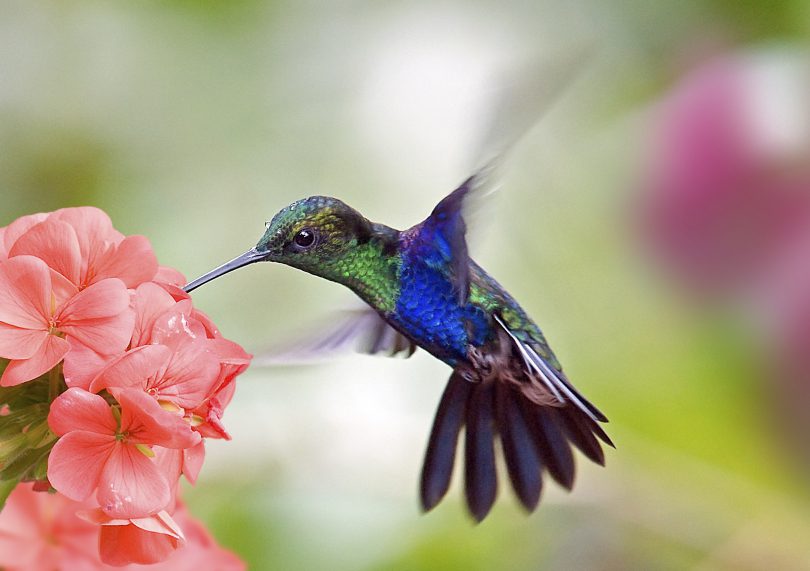By Vicki Spencer, Master Gardener
Over the past few years, we heard a lot about declines in native pollinator populations. This is a serious matter since there are multiple stressors and the world’s food production relies on pollinators. But sitting in my Gunnison backyard, I have to admit, it doesn’t feel like there is a crisis looming.
Bees are buzzing everywhere. Hummingbirds are visiting during their migration and native birds are flocking to bathe in the pond. Last year, I even saw an increase in butterflies and butterfly moths. Why all this activity?
My backyard is one big, incredible pollinator garden. I wish I could take full credit, but the previous owner provided the basic design. The yard is only 30-by-50 feet and is well-protected from the wind. My house sits on the west, juniper trees border the north with a 50-foot-high blue spruce in the northeast corner, wild roses and golden currant bushes grow against a tall brick wall on the east and a 6-foot fence borders the south. Tall grasses grow in a natural area under the conifer trees, and dried needles, branches and flowering woody shrubs provide plenty of pollinator shelter and nesting sites.
The yard is divided into five different garden beds with narrow, grassy paths that guide you from one bed to another. On the north, there is a cluster of three aspen trees, bunches of raspberry bushes, flowering vines, bleeding heart, yarrow and strawberries. Just to the south is a small pond surrounded by more raspberry bushes, pascal flowers, flax and lilies. The center garden bed is a focal point for most of the activity. Bees swarm to lavender, lupine, lilies, blanket flowers and Rocky Mountain penstemon. Russian and silver sage, clover and various ground covers keep the weeds at bay.
To the south is my columbine garden with five colorful varieties, sticky geraniums, harebells and asters. Morning glories and hops grow up the trellises that run along the patio, connecting the gardens, and provide the perfect perch for birds waiting to dip into the pond. The fifth garden borders the shrubs along the east wall and includes western yarrow, butterfly milkweed, blue flax, wild roses and sunflowers.
If you want to turn your garden into a haven for pollinators, you can find all kinds of information on the Internet, but here are a few tips:
• Consider planting flowering shrubs along the borders to provide protection from the wind. Some good choices are rabbitbrush, serviceberry, Wood’s rose and American plum.
• Choose plants that flower at different times of the year so there will be nectar and pollen sources throughout the growing season. A good rule of thumb is to begin with nine plant varieties: three that bloom early, three that bloom midsummer and three that bloom late. The flowers should be of different colors and shapes to attract different pollinators, but you want to plant each variety in clusters, rather than single as plants. The colors will stand out more and attract pollinators more effectively.
• Finally, you should choose native plants whenever possible. This is because native plants will attract more native pollinators and can serve as larval host plants for some of the pollinator species. Native plants have the added benefit of being well-adapted to local soils and climates.
Don’t feel compelled to cover the entire yard with plants and grass. Instead, preserve some natural areas with bare, well-drained soil and dead or dying plants. Hummingbirds typically nest in trees and shrubs. Butterflies often lay eggs on specific plants. If you want to attract certain butterflies, you should research their host plants. For example, monarch butterflies lay their eggs on milkweed plants. Most bees nest in the ground, in wood or dry plant stems. When pruning, you can provide bee nesting sites by cutting stems that are hollow or soft inside, like raspberries, roses, sumac and coneflower, and leaving some stems about a foot high. Instead of cutting back dead plants in the fall, leave them over the winter to provide a seed source and habitat for birds and other wildlife, then cut back in the spring.
The Xerces Society website, xerces.org, is a good resource for planning your pollinator garden. Look for the technical note, “Plants for Pollinators in the Intermountain West.” It includes a table of plants, their colors, when they bloom and which pollinators they attract. If you already have a flower garden, you might only need to add a few new plants, or make some simple adjustments in how you garden. It won’t be long before you can watch all the pollinators busily at work.

